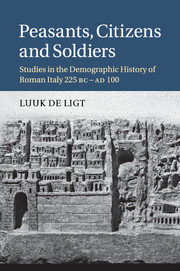Crossref Citations
This Book has been
cited by the following publications. This list is generated based on data provided by Crossref.
Bandelli, Gino
1970.
Le comunità della Transpadana dalla guerra gallica del 225-222 a.C. alla "Lex Pompeia" dell’89 a.C. Dati recenti e problemi aperti su alcuni aspetti di ordine istituzionale.
Gerión. Revista de Historia Antigua,
Vol. 35,
Issue. 2,
p.
373.
Levick, B. M.
2013.
Roman History.
Greece and Rome,
Vol. 60,
Issue. 1,
p.
166.
2013.
BOOKS RECEIVED.
The Classical Review,
Vol. 63,
Issue. 1,
p.
307.
2013.
A Companion to the Archaeology of the Roman Republic.
p.
611.
Santangelo, Federico
2014.
Roman Politics in the 70sb.c.: a Story of Realignments?.
Journal of Roman Studies,
Vol. 104,
Issue. ,
p.
1.
Flower, Harriet I.
2014.
The Cambridge Companion to the Roman Republic.
Ligt, Luuk
2014.
A Companion to Greek Democracy and the Roman Republic.
p.
368.
Sewell, Jamie
and
Witcher, Robert
2015.
Urbanism in Ancient Peninsular Italy: developing a methodology for a database analysis of higher order settlements (350 BCE to 300 CE).
Internet Archaeology,
2016.
A Companion to the Flavian Age of Imperial Rome.
p.
565.
Helm, Marian
2017.
A Troubled Beginning: Rome and its Reluctant Allies in the Fourth Centurybc.
Antichthon,
Vol. 51,
Issue. ,
p.
202.
Isayev, Elena
2017.
Migration, Mobility and Place in Ancient Italy.
Lo Cascio, Elio
2018.
A Companion to the City of Rome.
p.
137.
Maschek, Dominik
2018.
NotCensusbutDeductio: Reconsidering the ‘Araof Domitius Ahenobarbus’.
Journal of Roman Studies,
Vol. 108,
Issue. ,
p.
27.
Karambinis, Michalis
2018.
Urban Networks in the Roman Province of Achaia (Peloponnese, Central Greece, Epirus and Thessaly).
Journal of Greek Archaeology,
Vol. 3,
Issue. ,
p.
269.
Séguy, Isabelle
2019.
Finding the Limits of the Limes.
p.
23.
Terrenato, Nicola
2019.
The Early Roman Expansion into Italy.
Rüpke, Jörg
2019.
Religion als Urbanität: Ein anderer Blick auf Stadtreligion.
Zeitschrift für Religionswissenschaft,
Vol. 27,
Issue. 1,
p.
174.
Bowden, Bradley
2019.
The Palgrave Handbook of Management History.
p.
1.
Sinner, Alejandro G.
and
Carreras, Cesar
2019.
Methods of Palaeodemography: The Case of the Iberian Oppida and Roman Cities in North‐East Spain.
Oxford Journal of Archaeology,
Vol. 38,
Issue. 3,
p.
302.
Balbo, Mattia
2020.
Roman Frugality.
p.
213.





